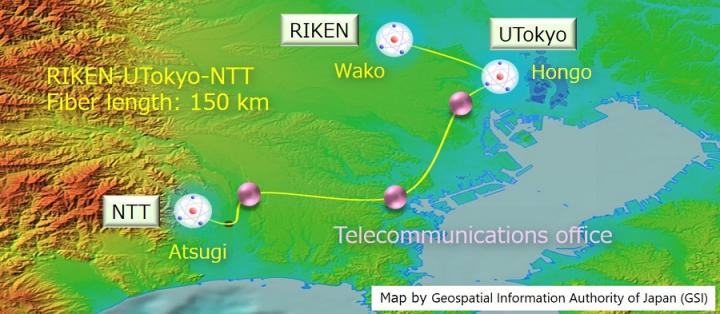Low-noise links between high-precision clocks could benefit early earthquake detection and other applications

Credit: Tomoya Akatsuka, Nippon Telegraph and Telephone Corporation
WASHINGTON — An academic-industrial team in Japan has connected three laboratories in a 100-kilometer region with an optical telecommunications fiber network stable enough to remotely interrogate optical atomic clocks. This type of fiber link is poised to expand the use of these extremely precise timekeepers by creating an infrastructure that could be used in a wide range of applications such as communication and navigation systems.
“The laser system used for optical clocks is extremely complex and thus not practical to build at multiple locations,” said Tomoya Akatsuka, a member of the research team from telecommunications company Nippon Telegraph and Telephone Corporation (NTT). “With our network scheme, a shared laser would enable an optical clock to operate remote clocks with much simpler laser systems.”
In The Optical Society (OSA) journal Optics Express, researchers from NTT, the University of Tokyo, RIKEN, and NTT East Corporation (NTT East), all in Japan, report the new low-noise fiber link.
“Optical clocks and optical fiber links have reached the stage where they can be put into practical use,” said Akatsuka. “Our system is compatible with existing optical communication systems and will help accelerate practical applications. For example, because optical clocks are sensitive to gravitational potential, linked clocks could be used for highly sensitive detection of early signs of earthquakes.”
Dealing with noise
Because of optical clocks’ extremely high precision, noise is a critical issue when linking optical clocks over a long fiber link. Even small vibrations or temperature variations can introduce noise into the network that skews the laser signal enough that it no longer reflects what originally came from the optical clock.
“Although optical clock networks that simply connect distant clocks have been demonstrated in Europe, our scheme is more challenging because operating remote clocks with the delivered light requires a more stable fiber link,” said Akatsuka. “In addition, the country’s urban environments tend to contribute more noise to fiber networks in Japan. To cope with that noise, we used a cascaded link that divides a long fiber into shorter spans connected by ultralow-noise laser repeater stations that incorporate planar lightwave circuits (PLCs).”
Optical interferometers fabricated on a small PLC chip were key for enabling a fiber link with extremely low noise. These interferometers were used in laser repeater stations that copy the optical phase of the received light to a repeater laser that is sent to a next station with fiber noise compensation. Applying noise compensation for each short span makes the laser signal less susceptible to noise and thus more stable.
“Optical interferometers fabricated on a PLC chip have an unprecedented stability and provide a compact, robust and ultralow-noise optical system,” said Akatsuka. “This is very advantageous when constructing cascaded fiber links in noisy environments such as those found in Japan.”
Connecting the laboratories
To demonstrate the system, the researchers sent laser light at a wavelength of 1397 nanometers through an optical fiber from RIKEN to the University of Tokyo and NTT. Using another fiber link, they measured a beat signal between the shared lasers at the University of Tokyo and NTT to evaluate the link stability for a 240-kilometer-long fiber loop. As expected, the results showed that the cascaded link was better than a non-cascaded link.
The laser’s 1397-nanometer wavelength is twice that of the laser used to create the most stable type of optical clock known as a strontium optical lattice clock. This means that the fiber network could be used to operate many distant strontium optical lattice clocks via a shared laser.
The researchers are now preparing optical lattice clocks to demonstrate a clock network using this fiber link and are working to make electrical components of the system more practical.
###
This work was partly funded by JSPS Grant-in-Aid for Specially Promoted Research (JP16H06284) and by JST-Mirai Program (JPMJMI18A1), Japan.
Paper: T. Akatsuka, T. Goh, H. Imai, K. Oguri, A. Ishizawa, I. Ushijima, N. Ohmae, M. Takamoto, H. Katori, T. Hashimoto, H. Gotoh, T. Sogawa, Optical frequency distribution using laser repeater stations with planar lightwave circuits, Opt. Express, 28,7, 9186-9197 (2020).
DOI: https:/
About Optics Express
Optics Express reports on scientific and technology innovations in all aspects of optics and photonics. The bi-weekly journal provides rapid publication of original, peer-reviewed papers. It is published by The Optical Society (OSA) and led by Editor-in-Chief James Leger of the University of Minnesota, USA. Optics Express is an open-access journal and is available at no cost to readers online at OSA Publishing.
About The Optical Society
Founded in 1916, The Optical Society (OSA) is the leading professional organization for scientists, engineers, students and business leaders who fuel discoveries, shape real-life applications and accelerate achievements in the science of light. Through world-renowned publications, meetings and membership initiatives, OSA provides quality research, inspired interactions and dedicated resources for its extensive global network of optics and photonics experts. For more information, visit osa.org.
Media Contact:
[email protected]
Media Contact
James Merrick
[email protected]
202-416-1994
Original Source
https:/
Related Journal Article
http://dx.




